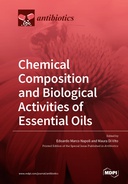Explore

Chemical Composition and Biological Activities of Essential Oils
0 Ungluers have
Faved this Work
Login to Fave
Essential oils extracted by the distillation or hydrodistillation of aromatic plants are a complex mixture of volatile compounds with several biological activities. Their efficacy as antimicrobial agents is related to the activity of several natural compounds belonging to different chemical families that can act both in synergy with each other and with other antibiotics. The antibiotic resistance detected among pathogens has been quickly increasing in recent years, and the control of some of these microorganisms is becoming a planetary emergency for human and animal health. The control of the microbial growth is a problem of great importance also for the food industry (food deterioration and shelf life extension) and for the world of cultural heritage (indoor and outdoor phenomena of biodeterioration). Essential oils can play an important role in this scenario, due their recognized broad-spectrum antimicrobial activity. Therefore, the main subject of this Special Issue includes an essential oil-based approach to control microrganisms in areas such as human and veterinary medicine, entomology, food industry and agriculture. In addition, the chemical composition of essential oils from endemic and rare medicinal/aromatic plants, nanoformulations of essential oils, applications in human and veterinary medicine and its use as animal feeding supplements are topics covered in this Special Issue
This book is included in DOAB.
Why read this book? Have your say.
You must be logged in to comment.
Rights Information
Are you the author or publisher of this work? If so, you can claim it as yours by registering as an Unglue.it rights holder.Downloads
This work has been downloaded 80 times via unglue.it ebook links.
- 80 - pdf (CC BY) at Unglue.it.
Keywords
- 1,8-cineole
- ABTS
- Acinetobacter baumannii
- Alternaria alternata
- antifungal activity
- antimicrobial
- antimicrobial activity
- antimicrobial resistance
- antioxidant activity
- Biofilm
- Boswellia sacra
- Candida albicans
- carvacrol
- cellulose synthesis
- chemometrics
- ciprofloxacin
- cucurbits
- Cymbopogon citratus
- Cytotoxicity
- enzyme inhibition
- essential oil
- essential oils
- eugenol
- extracellular polymeric substance matrix
- Ferula
- frankincense essential oil
- GC
- GC-MS
- GC/MS
- GC/MS analysis
- Gene expression
- Genetic
- growth inhibition
- human semen
- lamb
- Lavandula angustifolia
- Lavandula intermedia
- linalool
- Malassezia furfur
- marine bacteria
- MDR
- meat tenderness
- metabolic pathway analysis
- Monarda didyma
- Monarda fistulosa
- monensin
- Myrtaceae
- n/a
- nanoencapsulation
- Nitric Oxide
- nitrite
- Origanum hirtum
- Origanum vulgare
- Penicillium rubens
- pig farms
- Pimenta
- poly(ε-caprolactone)
- poultry farms
- Propionibacterium acnes
- Pseudomonas aeruginosa
- RAPD
- RNA microarray
- rosewood
- Salmonella
- Satureja montana
- Stagonosporopsis cucurbitacearum
- Staphylococcus aureus
- Staphylococcus spp.
- TBARs
- Technology, engineering, agriculture
- Technology: general issues
- thyme
- Thymus capitatus
- Thymus quinquecostatus
- Thymus vulgaris
- Trypanosoma cruzi
- wound infection
Links
DOI: 10.3390/books978-3-0365-1251-8Editions

